
clip2latent
Official demo for clip2latent: Text driven sampling of a pre-trained StyleGAN using denoising diffusion and CLIP, accepted to BMVC 2022
Get the code on GitHub, see the paper on Arxiv.

Official demo for clip2latent: Text driven sampling of a pre-trained StyleGAN using denoising diffusion and CLIP, accepted to BMVC 2022
Get the code on GitHub, see the paper on Arxiv.

Justin N. M. Pinkney and Chuan Li @ Lambda Inc.
Abstract:
We introduce a new method to efficiently create text-to-image models from a pre-trained CLIP and StyleGAN.
It enables text driven sampling with an existing generative model without any external data or fine-tuning.
This is achieved by training a diffusion model conditioned on CLIP embeddings to sample latent vectors of a pre-trained StyleGAN, which we call clip2latent.
We leverage the alignment between CLIP’s image and text embeddings to avoid the need for any text labelled data for training the conditional diffusion model.
We demonstrate that clip2latent allows us to generate high-resolution (1024x1024 pixels) images based on text prompts with fast sampling, high image quality, and low training compute and data requirements.
We also show that the use of the well studied StyleGAN architecture, without further fine-tuning, allows us to directly apply existing methods to control and modify the generated images adding a further layer of control to our text-to-image pipeline.
Trained using Lambda GPU Cloud